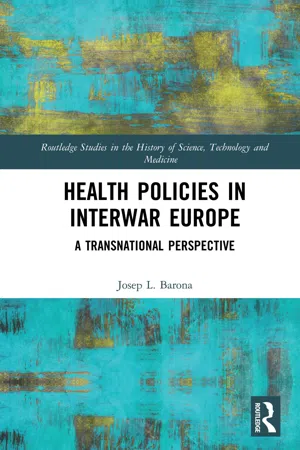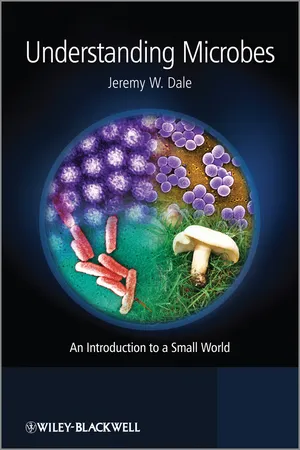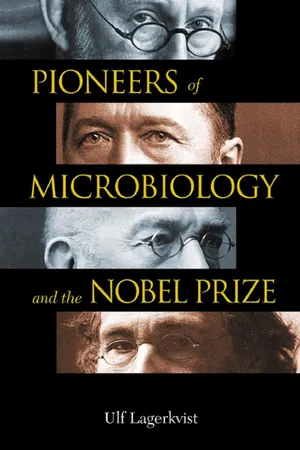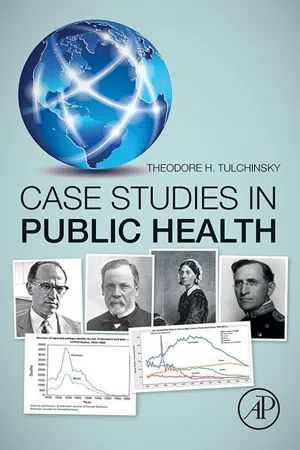Biological Sciences
Robert Koch
Robert Koch was a pioneering German physician and microbiologist known for his groundbreaking work in the field of bacteriology. He is credited with identifying the causative agents of several diseases, including anthrax, tuberculosis, and cholera. Koch's postulates, a set of criteria for establishing the causative relationship between a microbe and a disease, have had a lasting impact on the field of microbiology.
Written by Perlego with AI-assistance
Related key terms
5 Key excerpts on "Robert Koch"
- eBook - ePub
Health Policies in Interwar Europe
A Transnational Perspective
- Josep L. Barona(Author)
- 2018(Publication Date)
- Routledge(Publisher)
Some of its employees were involved in human clinical trials in concentration camps. Towards the end of World War Two, the activities of the institute could only be continued to a limited extent due to bomb damage, personnel shortages, and material deficiencies. After the war, the remaining employees initially worked under difficult conditions. In 1952 the institute became part of the newly founded Bundesgesundheitsamts [Federal Health Office], but it was not until the 1960s that the researchers again enjoyed modern facilities and rooms. An important aspect of the institute was the attention devoted to technical facilities. Microscopy had always played a central role in the research on infectious diseases. The Ernst Leitz optical works were one of the world’s most successful microscope manufacturers at the beginning of the twentieth century. In 1907, they built their 100,000th piece and handed it to Robert Koch. His research on anthrax experiments achieved a milestone when he could observe the pathogen material in infected animals and then transmitted the disease to mice, which he had previously infected with anthrax. Koch observed that the infection was triggered by some sort of chain-forming bacteria. He also saw punctate structures in the anthrax bacteria – the so-called spores – when he observed them in dried preparations and recognised that only spore-containing material was capable of being infected. He drew these observations carefully and used microphotography as one of the best procedures for representing the results objectively. 17 In the late nineteenth century, various technical developments were quickly driving the field of bacteriological and serological research. Microscopy was one of them. The physicist Ernst Abbe developed lenses with such a high resolution that, for example, mycobacteria, including the causative agent of tuberculosis, could be observed - eBook - ePub
Understanding Microbes
An Introduction to a Small World
- Jeremy W. Dale(Author)
- 2012(Publication Date)
- Wiley-Blackwell(Publisher)
As well as the controversy regarding the source of infection, we also have to remember that, at that time, no organisms had yet been identified as causing infections. Microbes had been seen as early as the 17th century (by Antonie van Leeuwenhoek – see Chapter 1), but it was not until the late 19th century that the first real proof was obtained that they could cause disease. They key person we associate with this was Robert Koch, who established a set of principles that are still referred to as the ideal way of establishing such a link. Koch's postulates can be summarized as requiring it to be shown:1. that the organism could be isolated from a patient;2. that it could be grown in pure culture;3. that the culture would produce the same condition in an experimental animal; and4. that the same organism could be recovered from the infected animal.It should be noted that for many well established causes of diseases, it is not possible to fulfil all of these postulates. For example, the bacterium that causes leprosy cannot be grown in the laboratory, so failing at the first hurdle – but that does not prevent scientists from arguing about the need to demonstrate them in controversial diseases. Using this approach, Koch identified the bacterium (Vibrio cholerae) that causes cholera, in 1883.This highlights one of the strengths of an epidemiological analysis, such as that carried out by John Snow. It is possible to track down the source of a disease, and hence take decisions about how to prevent it, without knowing what causes it – and John Snow did not know about the bacterium that causes cholera.During the second half of the 19th century, there was a parallel development that would also contribute to getting rid of diseases that spread in this way, and again it was not based on knowledge of how these disease were spread. The amount of sewage and other rubbish that was deposited in the Thames had made it, in effect, an open sewer. As a consequence, it became extremely smelly and, on at least one occasion (known as the ‘Great Stink’, in 1858), sittings of Parliament had to be suspended because the smell was so bad. - eBook - ePub
- Ulf Lagerkvist(Author)
- 2003(Publication Date)
- WSPC(Publisher)
The almost explosive development of bacteriology during the latter decades of the 19th century depended to a large extent on two simple but exceedingly important technical improvements that were mainly due to Koch. The German pathologist Carl Weigert (1845–1904) had pioneered the use of synthetic aniline dyes to stain bacteria. Koch improved Weigert’s procedure by the simple expedient of drying thin layers of bacteria on glass slides so as to fix them to the glass surface before staining. They could then be inspected and photographed in the microscope. The pictures that he obtained using this technique were so sharp and detailed that they could, for instance, be used to characterize and classify the bacteria found in infected wounds. When Koch demonstrated his results to one of Germany’s leading pathologists, Julius Cohnheim (1839–1884), and a group of scientists that included his future collaborator and close friend, Paul Ehrlich, they were received with great interest and appreciation. On the other hand, a later visit to the Nestor of German pathology, Rudolf Virchow in Berlin, was not as successful. Virchow was not inclined to accept the role of microorganisms in contagious diseases and instead entertained views that were almost miasmatic. In coming years, Koch and Virchow would often be on collision paths with each other.Koch was a strong adherent of Cohn’s theory that bacterial species had characteristic morphological and physiological properties that remained constant for countless generations, and in 1878 he became involved in a heated discussion with Karl von Nägeli who had expounded his pleomorphistic ideas in a recent book. Koch’s tendency to assert his opinions in a clear and unequivocal, not to say brutal way, would time and again lead to conflicts with other scientists, among them also one of his most outstanding collaborators, Emil von Behring. The same year that Koch had quarrelled with Nägeli, he published his important study of wound infections: Untersuchungen über die Ätiologie der Wundinfektionskrankheiten (“Studies of the Etiology of Wound Infections ”). This had for a long time been a contested question even after the majority of physicians had accepted that wound infections were caused by bacteria. Joseph Lister had been inclined to pleomorphistic ideas and the same could be said of Theodor Billroth with his hypothesis about all wound infections being caused by the same bacterium, Coccobacteria septica .Using tissue samples from infected wounds, Koch was able to transmit the infection to laboratory animals. When he analyzed the experimental infections, that eventually killed the animals, he could demonstrate a number of morphologically different bacterial species. He concluded that wound infections could be caused by a variety of bacteria belonging to genetically different species, to use a modern terminology. Koch’s arguments convinced both Lister and Billroth, who from now on supported his theory of specific bacterial species causing defined diseases. Another important result of Koch’s work with wound infections were his famous postulates, that had in fact been earlier suggested by his old teacher Jakob Henle. The great difference is of course that while Henle based his postulates on purely theoretical considerations, Koch could present experimental evidence to sustain his theses. Koch’s postulates can be summarized approximately as follows: - eBook - ePub
- Theodore H. Tulchinsky(Author)
- 2018(Publication Date)
- Academic Press(Publisher)
He demonstrated the efficacy of filtrating water in order to prevent of transmission of enteric diseases including cholera. His methods of investigation in isolating the organism and demonstrating onward transmission of the disease led to the formulation of criteria of causation of diseases. In 1883, Koch adapted the clinician-pathologist Jacob Henle’s postulates on causation of disease. He established criteria for attribution of causation of a disease to a particular organism or agent. These were fundamental to establishing the science of bacteriology and the relationship of microorganisms to disease causation. The Koch–Henle postulates in their pure form were too rigid, and would limit identification of the causes of many diseases. But they were important to establish the Germ Theory and the scientific basis of bacteriology, competing with many other theories of disease that were still widespread in the late 19 th century, specifically the Miasma Theory, which was predominant in medical thinking, and the sociopolitical theory of Rudolph Virchow. The Miasma Theory contributed to the Sanitary Movement goal of reducing exposure to sewage. The societal factor in disease prevalence and prevention foretold by Virchow and others in the mid-19 th century became part of public health practice in the 20 th century when universal education and rising standards of living in industrial nations led to improved nutrition, and municipal sanitation of community water supplies and sewage drainage. As chronic diseases became the major health issues, a more complex approach than the single causation biomedical model became vital - eBook - ePub
Bacterial Pathogenesis
A Molecular Approach
- Brenda A. Wilson, Malcolm Winkler, Brian T. Ho(Authors)
- 2019(Publication Date)
- ASM Press(Publisher)
Box 2-2 ). The germ theory also provided a scientific explanation for the horrendous infection rates that occurred during surgery in the 19th century, where handwashing was not practiced routinely due to the prevailing belief at the time about the airborne transmission of disease. Joseph Lister (1827–1912) and others seized on the germ theory to develop antiseptics and sterilization methods for surgery that greatly improved survival rates. With these early studies in hand, a number of scientists were becoming more receptive to the notion of a microbial origin of infectious disease, which set the stage for establishing the principles governing how to make the microbe-disease connection.Koch’s Postulates: A Set of Criteria Used To Establish a Microbe-Disease ConnectionThe German microbiologist Robert Koch (1843–1910) sought to define a set of rules for establishing a connection between a particular microbe and a particular disease. Early versions of his proposed guidelines, published first in 1882 and revised in 1884, consisted of three criteria that needed to be satisfied to link a microbe with a disease. In his final version, published in 1890, Koch refined his proposed set of rules by adding a fourth criterion. These four criteria for establishing cause and effect came to be known as Koch’s postulates (Table 6-1 ).Table 6-1. Koch’s postulates: then and nowKoch formulated his postulates based on elegant and detailed studies that he conducted over many years, beginning with his earlier work on anthrax and the life cycle of its causative bacterium, Bacillus anthracis . Although B. anthracis is now widely recognized as a potential biological weapon (see chapter 20 ), this bacterium is found in the environment, where it infects and kills livestock and wild herbivores (Figure 6-2
Learn about this page
Index pages curate the most relevant extracts from our library of academic textbooks. They’ve been created using an in-house natural language model (NLM), each adding context and meaning to key research topics.




